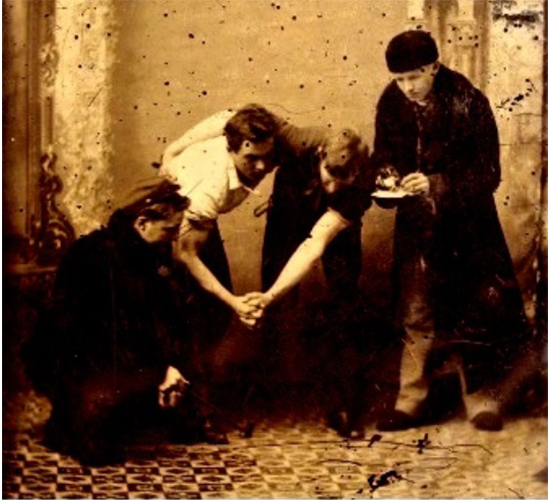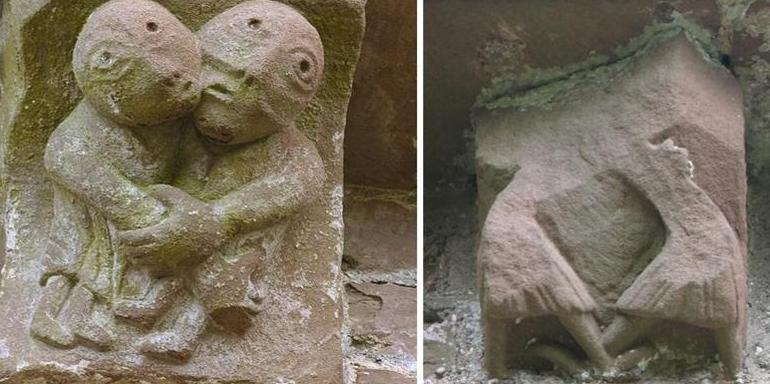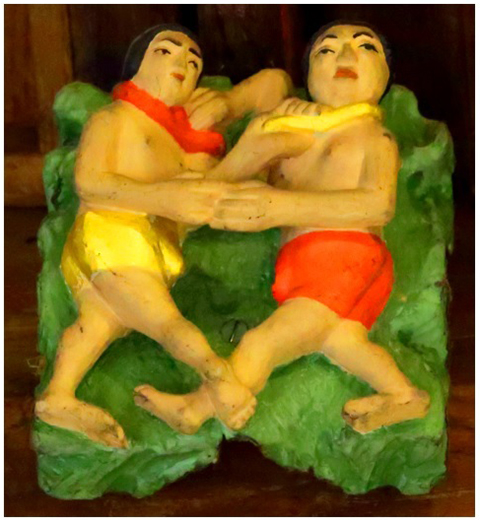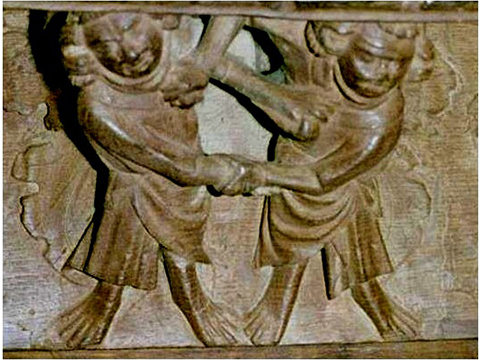
Side-Hold (United States & Canada)
This article is dedicated to my dear Ohioans the fans of pro wrestling and its great history. It happened here in Ohio in the very heart of Midwest where the side-hold style of wrestling truly blossomed and dominated local wrestling customs.
The Side-Hold was a North American fixed hold folk wrestling style, which in the 19th century was very popular among the farmers of British descent who were residents of the Midwest of the United States and the province of Ontario, Canada (province of upper Canada in the 1800s).
Despite being of English origin, the Side-Hold wrestling style was long forgotten and unknown in England in the 1800s. The most famous visualizations of the old English Side-Hold wrestling match are the following:
1) A 12th century sculpture at the Church of St. Mary and St. David, Kilpeck, Herefordshire.

This Norman artwork shows two men standing side to side having their inside arms around each others bodies, and one of the wrestlers is grabbing the other by the elbow with the hand of his outside arm.
Notably, this sculpture is not the only image of wrestlers in that church the other one shows two wrestlers in old English Back-Hold, the Hug.-
2) A 14th century roof boss sculpture from the St Lawrence Church, Lechlade, Gloucestershire.

3) A 16th century misericord wood carving at the Ely Cathedral, City of Ely, Cambridgeshire.

Both these pieces of art portray two men standing side to side having collar holds of each other with the hands of their inside arms and hands of their outside arms are clasped. ? Among the famous practitioners of Side-Hold wrestling were: the future president of the United States Abraham Lincoln (1809-1865), during his early years in Illinois (1830s); and the founder of the Church of Jesus Christ of Latter-day Saints Joseph Smith Jr. (1805-1844), during his years in Kirtland, Ohio (1830s); the great Iowans, legendary Martin Farmer- Burns (1861-1937), who fathered generations of top-notch American pro-wrestlers, as well as his most famous student, Frank Alvin Gotch (1877-1917), who is generally regarded as one of the greatest American pro wrestlers of the 20th century, in the years of their youth were both adept in the Side-Hold wrestling.
In the 1600s and 1700s North American (or colonial) wrestling customs weren't much different from those of the contemporary English. In general the wrestling matches were played either out of interest (amateur) or for a small purse (semi-professional). Those contests were usually held on such days as May Day, Good Friday, Whit Monday, Shrove Tuesday, Wakes, and other folk and religious festivals and even on the Sunday markets. These practices were brought to America by English pioneers among other their customs and pastimes.
During that era, North American wrestling was represented by the following styles of English origin: Arm's Length (after the Norfolk fashion), Close Struggle (after the Bedfordshire fashion), Cornish/Devonshire Catch-Hold of the jackets above the waist, old English Back-Hold or the Hug- (archaic trial of strength in which wrestling techniques weren't allowed and physical strength was a decisive factor), and English Catch-Hold of the body above the waist.
There also was the Run, Catch and Throw- style of wrestling, which was a standing Catch-as-Catch-Can style presumably of Germanic origin. According to the famous master of arms and wrestling scholar from Milan, Italy named Pietro Monti (1457-1509) the wrestling customs of Germanic people allowed holds of any part of the person's body in wrestling matches. The practice of unrestrained wrestling style in medieval, western continental European countries with the population of Germanic ethnic background is well documented.
Among the white settlers of North America along with wrestling styles of European heritage, the Native American wrestling games such as Indian Hug- (Back Hold) and Indian free-for-all wrestling (up and down Catch-as-Catch-Can) were also popular. In America during that era an organized wrestling prize-ring, unlike in England, didn't exist.
In different parts of the United States different wrestling styles prevailed. The Eastern men ("yankees") preferred Square-Hold (which is Collar and Elbow, or wrestling at arm's length), those from the Middle States; Side-Hold, and the southern and western men used Breeches Hold and old Indian Hug.
The most popular American folk wrestling styles were Collar and Elbow (fixed hold wrestling at Arm's Length, which featured the art of Hooking Legs, Tripping and Kicking) and Side-Holds (a fixed hold variation of Close Struggle, or Hugging and Heaving which featured the famous Hip-Lift Technique). Both those styles were descendants of historical English folk styles such as Collar Wrestling- and Girdle (Holdster) Wrestling.- Those two styles at some point of their evolution merged into what became known as the Catch-Hold of jackets above the waist or Cornish/Devonshire Wrestling. In America medieval English folk wrestling the condition of grasping alike and maintaining the original hold (fixed hold wrestling or a fair wrestle-), unlike in England, remained unchanged till the end of 19th century.
One of the most popular American pro-wrestlers of the 1850s, the Native American wrestling star named Caesar Coit, of Brooklyn, who was only 5 foot 2 inches tall and weighed 155 pounds, was considered invincible in the Side-Holds contests.
In the 1860s the American pro wrestling ring was finally established, being exclusively represented by the following wrestling styles: Collar-and-Elbow, Side-Hold, Cumberland and Westmorland Back-Hold and Cornish Catch-Hold of the jackets above the waist. During that era the professional Lancashire Catch wrestling matches were also contested. Those were mainly restricted to the mining communities of immigrants from East Lancashire or West Riding of Yorkshire. The Lancashire style was completely unknown to any others communities.
?In 1864 the first ever (known) official American Pro Side-Hold Wrestling Championship (Shoulder and Hip variation of Side-Hold) was decided in New York City at the Cremorne Gardens (corner of 72nd Street and 3rd Avenue). A sum of $1,000 was at stake in that two out of three fair back falls match. A New Jersey athlete called Uzile Prickett, who was considered the best overall pro wrestler of United States defeated Harry Hill of New York (late of Epsom, England) two falls to none.

?In early 1870 the International Wrestling Tournament Association for professionals was established in Detroit, Michigan. The president of that organization was Mr. Thomas Lewis of Detroit. First official Championship of United States and Canada in three styles (Collar and Elbow/Square-Hold, Side-Hold, and Back-Hold) was held at Young Men's Hall in Detroit on March 10th, 1870. The fair back fall (two shoulders and one hip or two hips and one shoulder down flat at the same time) constituted the victory in all contests. Breaking hold or three files- (foils, falls on any part of the body) also constituted a fall. Side-Hold contestants had the choice of upper and under holds by lot, unless they otherwise agreed. The Side-hold Championship was won by James Defoe of Detroit who was awarded a gold medal symbolic of this title. At first Defoe beat William Bell of London, Ontario (one fall to none), then beat Mathew Brown of London, Ontario (one fall to none), after that he beat Bell (one fall to none) again, and finally beat Brown (one fall to none) one more time. The organizers were thinking to make such championships annual like it was in London, England for Cumberland/Westmorland and Cornish/Devonshire styles, but that never happened. The 1870 tourney remained one of a kind pro wrestling championship of North America which was decided in the most popular folk wrestling styles. The winner of the most prestigious category the competition for the Collar and Elbow Championship was Col. James Hiram McLaughlin who received a champion diamond studded belt.
In the American Side-Hold contest both parties stood side to side facing one way (forward) usually clasping hands of their outside arms (sometimes by the mutual agreement they would decide to grab by either outside wrists, elbows, or shoulders); with their inside arms and hands they took the over- and under- holds respectively.
In the Canadian Side-Hold match the wrestlers stood side to side and were clutching with the hands of their outside arms a four inch woven ring; with the hands of their inside arms they took the over- and under- holds respectively.
Usually the men tossed coin for a choice of holds, the winner could take either the over- or the under- hold. Among the wrestlers the under-hold was considered advantageous, because it allowed easier levering of the opponent and throwing him down.
??It appears that in the medieval English Side-Hold wrestlers had to fight with their inside and outside arms and hands for the better holds. In that case inside holds were taken by either collars or belts and outside holds were taken by the hands, wrists or elbows. That probably caused a lot of breaking of the previously taken holds in order to achieve the most advantageous hold. Basically medieval Side-Hold was a Catch-Hold style of wrestling. This practice definitely prolonged the contests and being considered unnecessary or even unfair over the time was discontinued. It was decided to make Side-Hold a fixed hold wrestling style with a fair play based on the coin toss.
The fair back fall signified victory in the Side-Hold contests. The definition of a fair back fall varied depending on the mutual agreement between the wrestlers. It was either traditional English combination of shoulders and hips- (three or four points down back fall) or modern American rule of two shoulders- striking the ground simultaneously. The man whose back touched the floor first lost the match; any attempt to pull or turn the opponent over wasn't counted. Letting go the initial hold wasn't allowed. Either man was allowed to drop on one or both his knees and rise again. Kicking, or grabbing either leg was considered unfair. Usually matches were played for one fall, two out of three, or three out of five falls. Ten to twenty minute breaks were allowed between the falls.
In 1883 the National Police Gazette of New York City released the standard Side-Hold rules for American pro-wrestlers. According to those rules each wrestler had to wear during the match a set of strong leather or Webb harness, which must reach from the shoulder to the waist and from the neck to the elbow. The coin toss decided the choice of holds, which could be either the right and over- (wrestler takes hold of opponent's harness behind the right shoulder with his right hand) or the left and under- (wrestler takes hold of opponent's harness at the waist with his left hand).
The most commonly used Side-Hold wrestling strategy was to swing suddenly or more effectively to get the knee behind that of the other wrestler and throw backward. Among other wrestling techniques popular in the Side-Hold contests were: The Hank, The Inside Lock Forward (performed both ways, forward or backward), The Cross-buttock (performed both ways, arm around the neck or arm around the body), The Buttock.
With popularization of Graeco-Roman and Catch-as-catch-can in the United States the traditional American folk wrestling styles such as Collar and Elbow and Side-Hold lost their significance and by the mid-1890s ceased to exist as pro-wrestling styles. The industrialization put an end to the practice of old rural wrestling styles in the farmers' communities of North America as well. In the 1880s Side-Hold wrestling along with Collar and Elbow and Back-Hold was still taught in most prestigious colleges around the USA as part of their physical education program, but it soon was replaced with the amateur Catch-as-catch-can of German Gymnastic Societies (Turners Catch). It was the birth of American amateur wrestling in America. Currently Side-Hold wrestling is not practiced anymore.
This article is based on The Story of Catch: The Story of Lancashire Catch-as-catch-can Wrestling. FIRST FIFTY YEARS 1820-1870![]() , by Ruslan C Pashayev. Get your copy today!
, by Ruslan C Pashayev. Get your copy today!
You can listen to my interview with Ruslan on my podcast here: The DO IT AGAIN Podcast: The Story of Catch w/ Ruslan Pashayev





